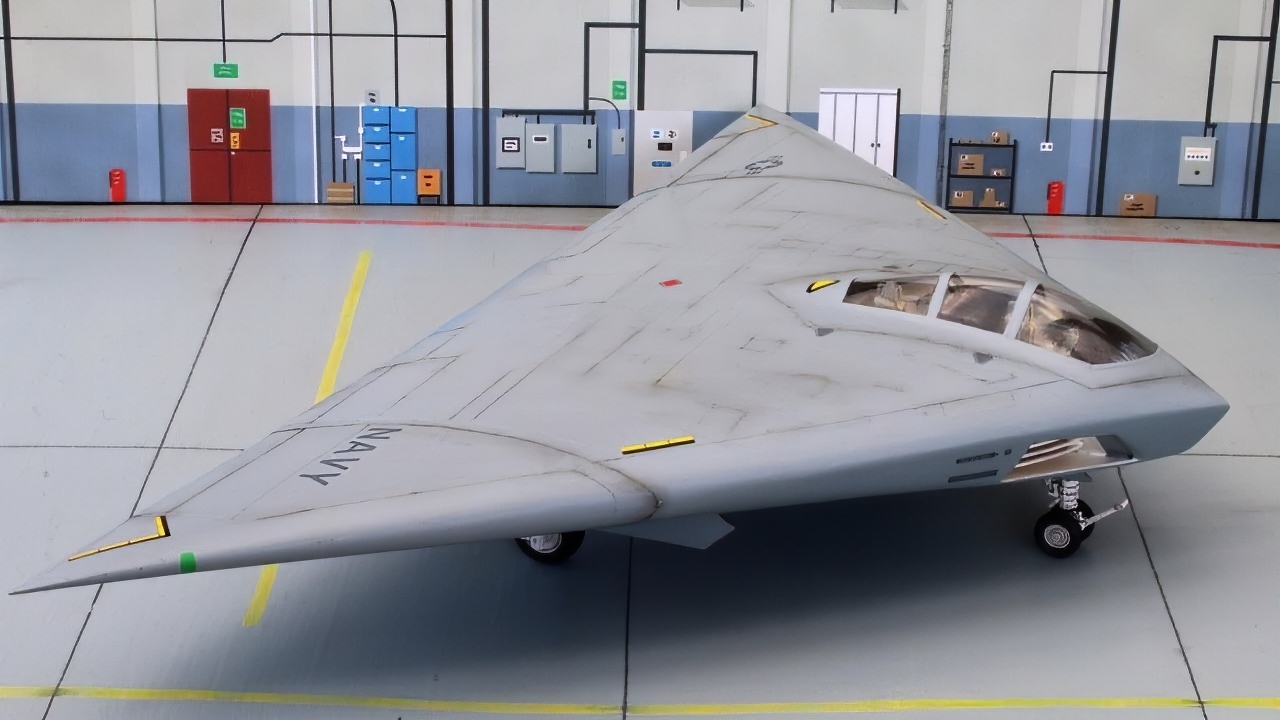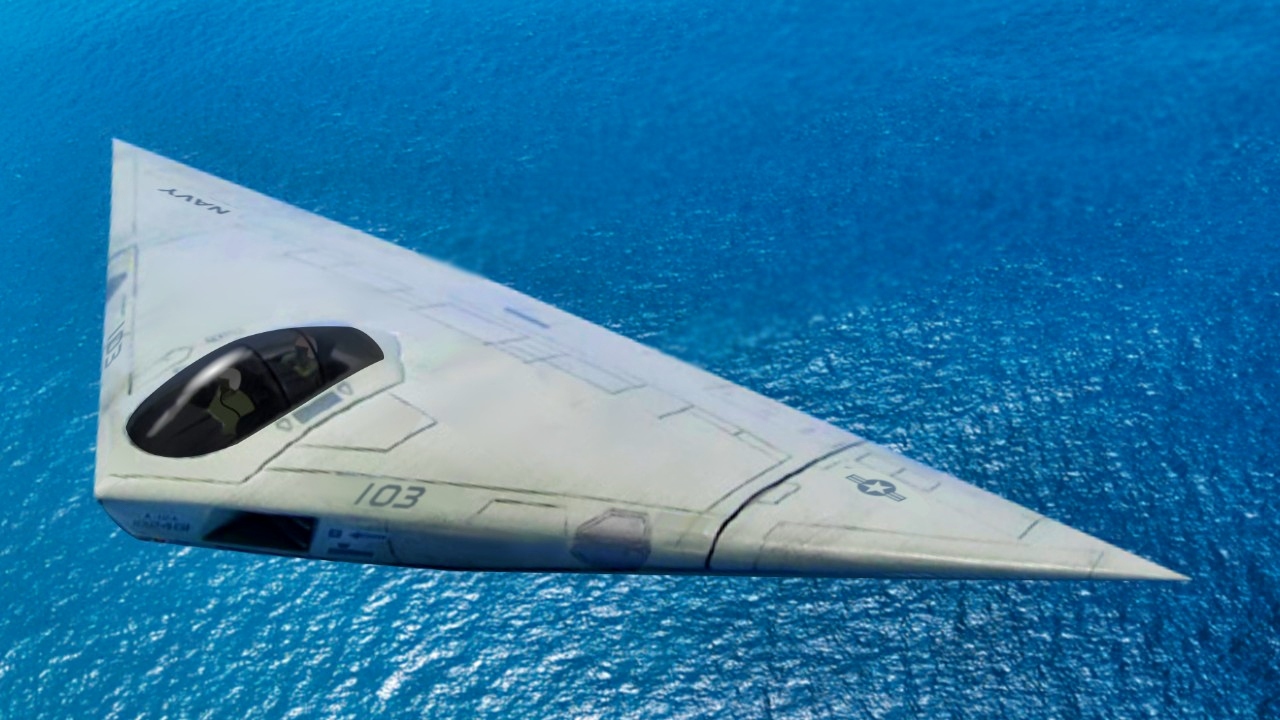Key Points and Summary – Conceived to replace the A-6, the stealthy, flying-wing A-12 Avenger II promised a carrier-borne, precision night striker with radar-killing HARMs and internal weapons.
-Selected in 1988, it ballooned in cost, weight and risk; secrecy, optimistic contractors, and weak oversight hid problems until Defense Secretary Dick Cheney canceled it in 1991 after $5B spent.
-The Navy fell back on Hornets and standoff tactics, losing a deck-based stealth penetrator and the chance to mature large-airframe composites a decade earlier.
-Later the X-47B revived the idea, but carrier air wings struggle for range against China—fueling debate whether canceling A-12 was prudence or blunder.
Was Cancelling the A-12 Avenger II A Needed Cut Or A Big Mistake?
The U.S. Navy made history about ten years ago by launching the stealthy X-47B demonstrator drone from the deck of an aircraft carrier. But the Navy had long pursued the technology to unlock a new era of carrier-based air attack. After the Air Force unveiled the first stealth aircraft in history, the F-117 Nighthawk, the Navy sought to introduce its own – a stealthy attack aircraft designed to replace the A-6 Intruder.
The result was the A-12 Avenger II, known as “The Flying Dorito” due to its triangular flying-wing shape.
The A-12 program was canceled in 1991 due to cost overruns, weight issues, and technological hurdles – particularly the difficulty of landing on a moving carrier. The cancellation came after $5 billion in research and development costs.
Meet The A-12 Avenger II
A McDonnell Douglas-General Dynamics team was selected in 1988 to develop the A-12. A team comprising Northrup, Grumman, and Vought dropped out and did not bid. The first flight was planned for December 1990. The A-12 was named Avenger II as a nod to the World War II-era Grumman TBF/TBM torpedo bomber.
Initially, the Navy wanted 620 A-12s, the Marines wanted 238, and the Air Force, contemplating a replacement for retiring F-111s, considered 400 A-12 variants.
A-12 Avenger II Design
Intended as a carrier-borne aircraft, the A-12 Avenger II was slightly more than 37 feet long, with a wingspan a shade more than 70 feet. These dimensions would have made the A-12 significantly shorter than the 55-foot-long Intruder, while having a far wider wingspan that extended just far enough to allow two A-12s to sit side-by-side on adjacent catapults on a carrier flight deck.
In fact, the A-12’s wingspan would have dwarfed even the F-14 Tomcat’s extended sweep wings by a good six feet.
The A-12 didn’t have a large payload. It could carry only 5,150 pounds of ordnance, far less than the 18,000 pounds of the Intruder. It was designed to deliver precision munitions.
Cancellation of the Program Highlighted Several Issues
Aviation historian James Stevenson wrote a book on the A-12 program. Stevenson found that changes in leadership, objectives, and funding “were bound to devastate the program.” However, the Pentagon itself contributed to the problems with an incredibly complicated system of procurement.
When then-Defense Secretary Dick Cheney canceled the program in January 1991, it sent shockwaves through the defense industry and the Pentagon. The U.S. was wrapping up one war in Panama and preparing to launch the air campaign for Desert Storm.
Air & Space Forces described four challenges the program faced.
– Overly protective Navy officials didn’t want to endanger the program by pointing out flaws. A Pentagon analyst first detected a possible cost overrun two years prior. Still, the Navy program manager continued to describe the A-12 as being on track until a Pentagon review in 1990.
– A “don’t-rock-the-boat” segment of the Pentagon bureaucracy was aware of problems but reluctant to buck superiors to press a case for solutions. In one incident, a report noting A-12 problems was tucked away and forgotten.
– Overly optimistic A-12 contractors miscalculated the extent of the technical difficulties involved in producing such a plane and kept these problems hidden from the government. An inquiry by Navy Deputy General Counsel Chester Paul Beach found that General Dynamics and McDonnell Douglas discovered “increasing cost and schedule variances,” but did not alert the Navy in a timely fashion.

A-12 Avenger II Flying Dorito. Image Credit: Creative Commons.
– Excessive secrecy blanketed the project and prevented examinations that might have brought problems to light. Officials were kept away, standard reporting procedures were abandoned, and information was transmitted verbally rather than in writing.
Was The Cancellation a Mistake? What Was Lost?
After the A-12 was cancelled, the Navy turned to the F/A-18 Hornet, which is an outstanding aircraft. Was anything deeper lost in the cancellation?
Alex Hollings from Sandboxx News wrote, “Like modern stealth aircraft in operation today, the A-12 Avenger was never intended to scream into the fight with its teeth bared. In the minds of many defense officials, its ability to strike targets without warning in highly contested airspace was more useful than a massive payload.
“Instead, stealth combined with highly accurate precision munitions would allow the A-12 Avenger II to strike enemy targets where it hurts most surgically.”
Think about how far technology would have evolved by now if the Navy had worked through the bugs in its stealthy “Flying Dorito.” Thanks to its stealth, it would be much more relevant today than the Hornets of 35 years ago.
At a top speed of 580-600 miles per hour, however, it was no fighter – but it could protect itself in a pinch. The Avenger was intended to carry AGM-88 HARM air-to-ground missiles. These anti-radiation missiles could home in on the electromagnetic waves emanating from early warning radar arrays and surface-to-air missile platforms. The aircraft would fly in unnoticed and take out enemy radars, which would clear the way for more heavily laden aircraft.
In terms of projected use, the A-12 Avenger II would have been able to serve in a similar capacity to today’s F-35 Joint Strike Fighters in contested airspace. It wouldn’t have been a bomb truck like the A-6, but it would take out a target quickly with precision munitions.
What the Experts Say on the A-12 Avenger II
Harry J. Kazianis, a defense expert and Editor of National Security Journal, wrote, “Instead of a stealthy, long-range, internally armed night attacker, carrier wings relied on non-stealth strike fighters with external tanks and weapons, using tactics, jamming, and standoff munitions to survive. Naval aviation adapted—it always does—but the geometry changed.
“A deck-based stealth striker would have shortened tanker strings, expanded target sets, and given the air wing more first-night options than it had for years afterward.
“We also lost an opportunity to industrialize large-airframe composites for saltwater life a decade earlier. The A-12’s struggles didn’t mean composites were wrong; they meant the learning curve hadn’t been paid yet. In aerospace, hard-won process knowledge rarely disappears; it migrates to the next program that’s ready to use it.”
Unfortunately for the Navy, that “next program,” the X-47B, didn’t fly for another 20 years, in 2011. And the Navy is still back to square one. Its carriers don’t have the assets and range to engage Chinese missiles until they sit well within those missiles’ range.
Was the A-12 Avenger too far ahead of its time to work? Quite possibly – 20 years later, the Navy is only now revisiting that technology.
And during this time, our enemies have been anything but asleep.
About the Author: Steve Balestrieri
Steve Balestrieri is a National Security Columnist. He served as a US Army Special Forces NCO and Warrant Officer. In addition to writing on defense, he covers the NFL for PatsFans.com and is a member of the Pro Football Writers of America (PFWA). His work was regularly featured in many military publications.
More Military
The U.S. Navy’s Big Medium Aircraft Carrier (CVV) Mistake Still Stings
Sweden’s JAS 39 Gripen E: The Secret That Makes It a Powerhouse Fighter
F-22N ‘Sea Raptor’: The Stealth Fighter The Navy Could Be Flying Right Now
The F-4E ‘Super’ Phantom Fighter Has a Message for Any Military On Earth
Forget the F-35: Canada’s Victoria-Class Submarine Problem Looks Serious










